What Is The Purpose Of Drawing Electric Field Lines
Electrical Charges and Fields
34 Electric Field Lines
Learning Objectives
Past the end of this section, y'all will be able to:
- Explain the purpose of an electric field diagram
- Describe the relationship between a vector diagram and a field line diagram
- Explain the rules for creating a field diagram and why these rules make physical sense
- Sketch the field of an capricious source accuse
Now that we have some experience calculating electric fields, let'south endeavour to gain some insight into the geometry of electric fields. Equally mentioned earlier, our model is that the charge on an object (the source charge) alters space in the region around information technology in such a mode that when another charged object (the test charge) is placed in that region of space, that test charge experiences an electric force. The concept of electrical field line s, and of electric field line diagrams, enables us to visualize the way in which the space is altered, assuasive united states to visualize the field. The purpose of this department is to enable you to create sketches of this geometry, so we will listing the specific steps and rules involved in creating an accurate and useful sketch of an electric field.
It is important to think that electrical fields are 3-dimensional. Although in this volume we include some pseudo-three-dimensional images, several of the diagrams that you'll see (both here, and in subsequent chapters) will be 2-dimensional projections, or cantankerous-sections. E'er keep in mind that in fact, you're looking at a three-dimensional phenomenon.
Our starting betoken is the physical fact that the electric field of the source charge causes a exam charge in that field to experience a forcefulness. By definition, electrical field vectors point in the aforementioned direction equally the electric force that a (hypothetical) positive test accuse would experience, if placed in the field ((Figure))
The electric field of a positive signal charge. A large number of field vectors are shown. Similar all vector arrows, the length of each vector is proportional to the magnitude of the field at each point. (a) Field in two dimensions; (b) field in three dimensions.
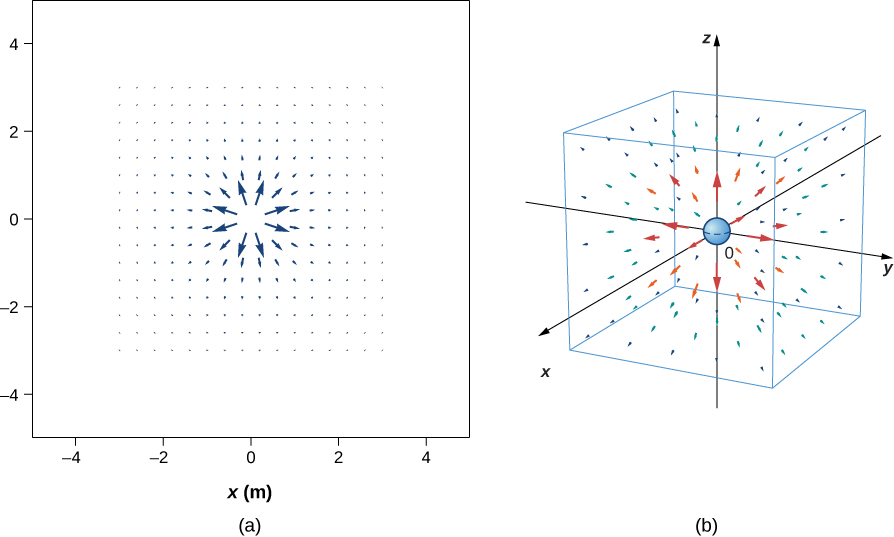
We've plotted many field vectors in the figure, which are distributed uniformly around the source charge. Since the electric field is a vector, the arrows that we draw correspond at every point in space to both the magnitude and the management of the field at that point. Every bit always, the length of the pointer that we draw corresponds to the magnitude of the field vector at that signal. For a betoken source charge, the length decreases by the square of the distance from the source charge. In addition, the management of the field vector is radially away from the source charge, because the direction of the electrical field is defined by the direction of the force that a positive test charge would experience in that field. (Again, proceed in heed that the bodily field is iii-dimensional; there are likewise field lines pointing out of and into the page.)
This diagram is correct, but information technology becomes less useful as the source charge distribution becomes more than complicated. For case, consider the vector field diagram of a dipole ((Figure)).
The vector field of a dipole. Even with just two identical charges, the vector field diagram becomes hard to understand.
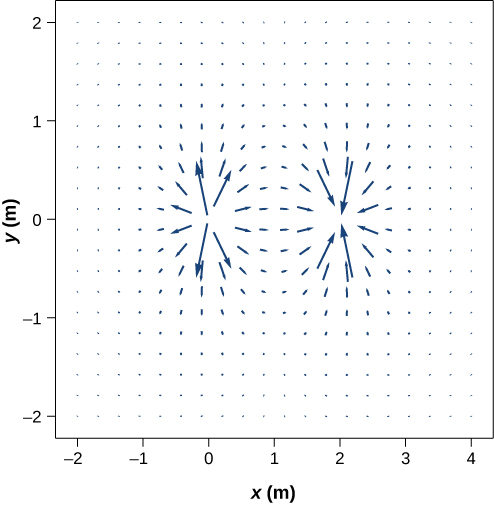
There is a more useful mode to present the same information. Rather than drawing a large number of increasingly smaller vector arrows, we instead connect all of them together, forming continuous lines and curves, as shown in (Figure).
(a) The electric field line diagram of a positive point charge. (b) The field line diagram of a dipole. In both diagrams, the magnitude of the field is indicated by the field line density. The field vectors (not shown hither) are everywhere tangent to the field lines.

Although it may not be obvious at first glance, these field diagrams convey the same information near the electric field as do the vector diagrams. Start, the direction of the field at every indicate is simply the direction of the field vector at that same point. In other words, at any signal in infinite, the field vector at each signal is tangent to the field line at that same betoken. The arrowhead placed on a field line indicates its direction.
As for the magnitude of the field, that is indicated by the field line density—that is, the number of field lines per unit surface area passing through a small cross-sectional expanse perpendicular to the electric field. This field line density is drawn to be proportional to the magnitude of the field at that cross-section. As a result, if the field lines are close together (that is, the field line density is greater), this indicates that the magnitude of the field is big at that point. If the field lines are far apart at the cross-section, this indicates the magnitude of the field is modest. (Figure) shows the thought.
Electrical field lines passing through imaginary areas. Since the number of lines passing through each area is the same, but the areas themselves are different, the field line density is different. This indicates unlike magnitudes of the electric field at these points.
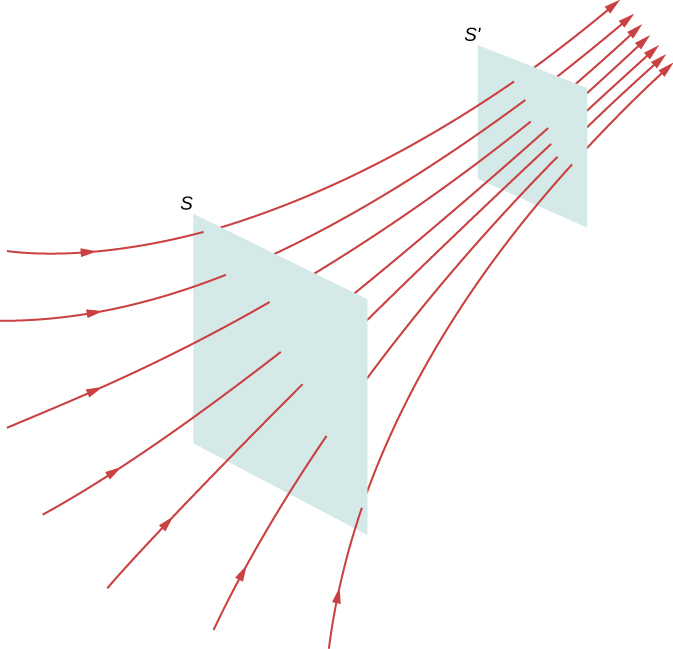
In (Figure), the aforementioned number of field lines passes through both surfaces (S and ![]() but the surface S is larger than surface
but the surface S is larger than surface ![]() . Therefore, the density of field lines (number of lines per unit area) is larger at the location of
. Therefore, the density of field lines (number of lines per unit area) is larger at the location of ![]() , indicating that the electric field is stronger at the location of
, indicating that the electric field is stronger at the location of ![]() than at S. The rules for creating an electric field diagram are equally follows.
than at S. The rules for creating an electric field diagram are equally follows.
Problem-Solving Strategy: Drawing Electric Field Lines
- Electrical field lines either originate on positive charges or come in from infinity, and either terminate on negative charges or extend out to infinity.
- The number of field lines originating or terminating at a charge is proportional to the magnitude of that charge. A charge of twoq will have twice every bit many lines every bit a charge of q.
- At every point in space, the field vector at that point is tangent to the field line at that same point.
- The field line density at any signal in infinite is proportional to (and therefore is representative of) the magnitude of the field at that point in space.
- Field lines can never cantankerous. Since a field line represents the direction of the field at a given point, if two field lines crossed at some point, that would imply that the electric field was pointing in two different directions at a unmarried indicate. This in plow would suggest that the (net) force on a exam charge placed at that indicate would point in 2 unlike directions. Since this is obviously impossible, it follows that field lines must never cross.
Ever keep in mind that field lines serve only as a convenient way to visualize the electrical field; they are not physical entities. Although the direction and relative intensity of the electric field can be deduced from a set of field lines, the lines can also be misleading. For example, the field lines drawn to stand for the electrical field in a region must, by necessity, be discrete. However, the actual electric field in that region exists at every signal in space.
Field lines for three groups of detached charges are shown in (Figure). Since the charges in parts (a) and (b) have the same magnitude, the aforementioned number of field lines are shown starting from or terminating on each charge. In (c), nevertheless, we describe iii times as many field lines leaving the ![]() charge as entering the
charge as entering the ![]() . The field lines that do not stop at
. The field lines that do not stop at ![]() emanate outward from the accuse configuration, to infinity.
emanate outward from the accuse configuration, to infinity.
Iii typical electrical field diagrams. (a) A dipole. (b) Two identical charges. (c) Ii charges with opposite signs and unlike magnitudes. Tin y'all tell from the diagram which charge has the larger magnitude?
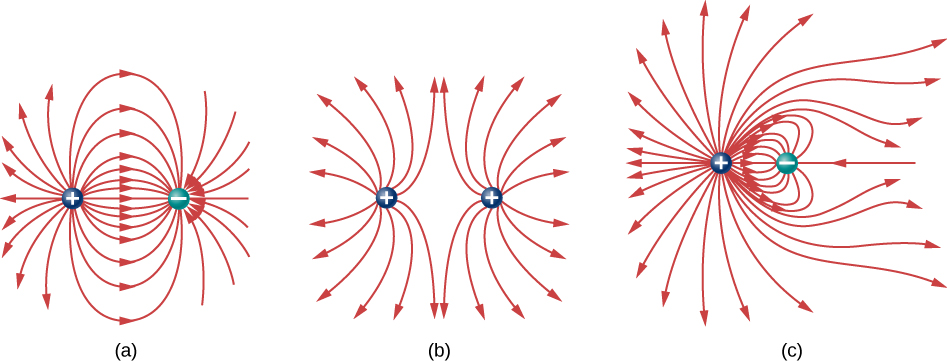
The power to construct an accurate electric field diagram is an important, useful skill; information technology makes it much easier to approximate, predict, and therefore calculate the electrical field of a source charge. The best way to develop this skill is with software that allows yous to place source charges then will draw the cyberspace field upon request. Nosotros strongly urge you lot to search the Internet for a program. Once you've found 1 you similar, run several simulations to go the essential ideas of field diagram structure. And so practice cartoon field diagrams, and checking your predictions with the reckoner-fatigued diagrams.
Summary
- Electric field diagrams assist in visualizing the field of a source charge.
- The magnitude of the field is proportional to the field line density.
- Field vectors are everywhere tangent to field lines.
Conceptual Questions
If a point charge is released from residual in a compatible electric field, will information technology follow a field line? Will information technology do and so if the electric field is not uniform?
yes; no
Under what conditions, if any, will the trajectory of a charged particle not follow a field line?
How would y'all experimentally distinguish an electrical field from a gravitational field?
At the surface of Earth, the gravitational field is ever directed in toward Earth'south eye. An electric field could movement a charged particle in a different direction than toward the heart of Earth. This would indicate an electric field is present.
A representation of an electric field shows ten field lines perpendicular to a foursquare plate. How many field lines should pass perpendicularly through the plate to depict a field with twice the magnitude?
What is the ratio of the number of electric field lines leaving a charge 10q and a charge q?
10
Bug
Which of the following electric field lines are wrong for signal charges? Explain why.
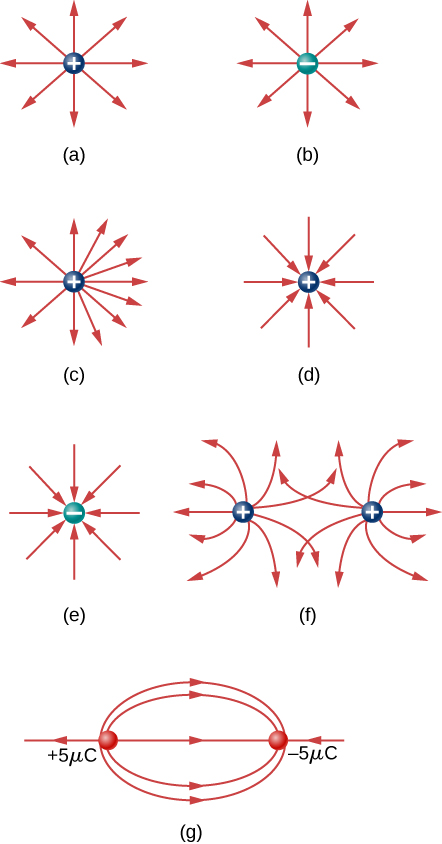
In this practise, y'all volition practice cartoon electric field lines. Make sure you stand for both the magnitude and management of the electric field fairly. Note that the number of lines into or out of charges is proportional to the charges.
(a) Describe the electric field lines map for two charges ![]() and
and ![]() situated v cm from each other.
situated v cm from each other.
(b) Draw the electrical field lines map for 2 charges ![]() and
and ![]() situated 5 cm from each other.
situated 5 cm from each other.
(c) Describe the electric field lines map for ii charges ![]() and
and ![]() situated v cm from each other.
situated v cm from each other.
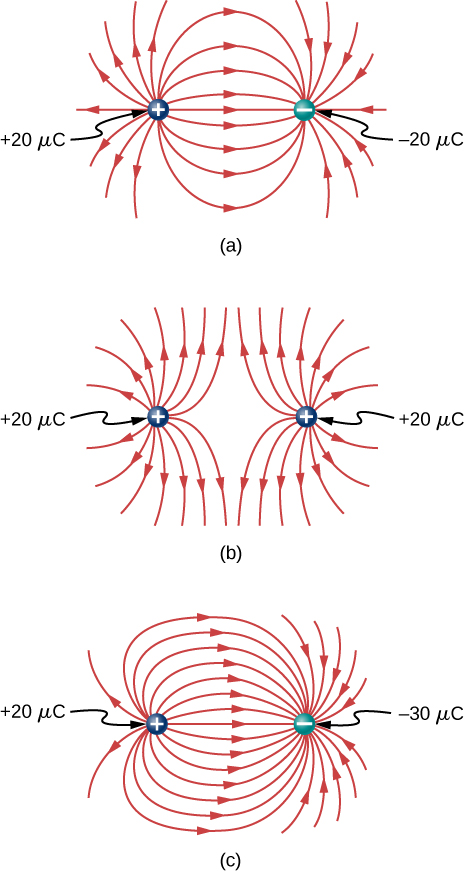
Two charges of equal magnitude merely opposite sign make up an electric dipole. A quadrupole consists of two electric dipoles are placed anti-parallel at ii edges of a square as shown.
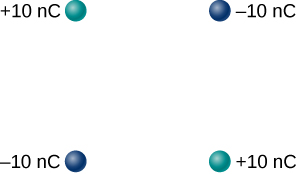
Describe the electric field of the charge distribution.
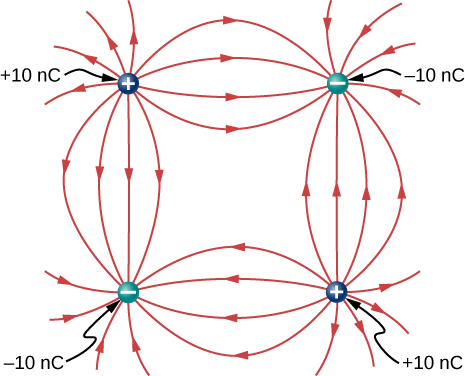
Suppose the electric field of an isolated point charge decreased with distance as ![]() rather than as
rather than as ![]() . Show that it is then impossible to describe continous field lines then that their number per unit area is proportional to Due east.
. Show that it is then impossible to describe continous field lines then that their number per unit area is proportional to Due east.
Glossary
- field line
- smooth, usually curved line that indicates the direction of the electric field
- field line density
- number of field lines per square meter passing through an imaginary area; its purpose is to indicate the field strength at dissimilar points in space
Source: https://opentextbc.ca/universityphysicsv2openstax/chapter/electric-field-lines/
Posted by: blancharddeve1941.blogspot.com


0 Response to "What Is The Purpose Of Drawing Electric Field Lines"
Post a Comment